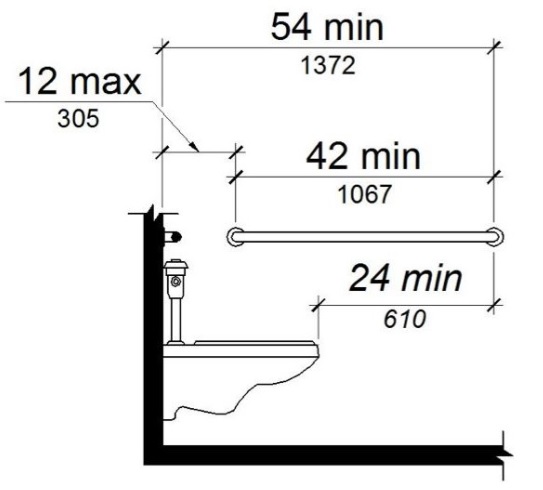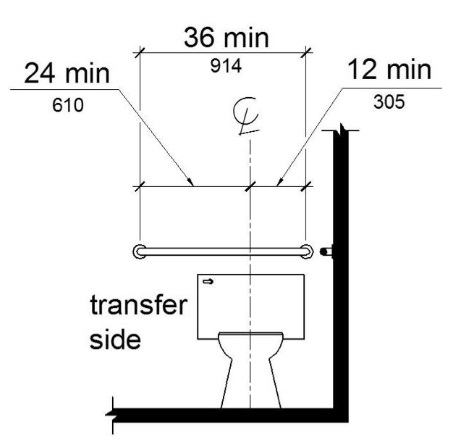2016 California Standards for Accessible Design Pocket Guide - Eff. Jan. 1, 2017
11B-604.5 Grab bars. Grab bars for water closets shall comply with Section 11B-609. Grab bars shall be provided on the side wall closest to the water closet and on the rear wall. Where separate grab bars are required on adjacent walls at a common mounting height, an L-shaped grab bar meeting the dimensional requirements of Sections 11B-604.5.1 and 11B-604.5.2 shall be permitted.
[2010 ADAS] 604.5 Grab Bars. Grab bars for water closets shall comply with 609. Grab bars shall be provided on the side wall closest to the water closet and on the rear wall.
Exceptions:
1. Reserved.
[2010 ADAS] 1. Grab bars shall not be required to be installed in a toilet room for a single occupant accessed only through a private office and not for common use or public use provided that reinforcement has been installed in walls and located so as to permit the installation of grab bars complying with 604.5.
2. In residential dwelling units, grab bars shall not be required to be installed in toilet or bathrooms provided that reinforcement has been installed in walls and located so as to permit the installation of grab bars complying with Section 11B-604.5.
3. In detention or correction facilities, grab bars shall not be required to be installed in housing or holding cells that are specially designed without protrusions for purposes of suicide prevention.
11B-604.5.1 Side wall. The side wall grab bar shall be 42 inches (1067 mm) long minimum, located 12 inches (305 mm) maximum from the rear wall and extending 54 inches (1372 mm) minimum from the rear wall with the front end positioned 24 inches (610 mm) minimum in front of the water closet.
[2010 ADAS] 604.5.1 Side Wall. The side wall grab bar shall be 42 inches (1065 mm) long minimum, located 12 inches (305 mm) maximum from the rear wall and extending 54 inches (1370 mm) minimum from the rear wall.

FIGURE 11B-604.5.1 ‡‡
SIDE WALL GRAB BAR AT WATER CLOSETS
ETA Editor's Note
At Hospital toilets and bathrooms used by patients, the California Electrical Code (CEC) requires a nurse call device at the side wall of a water closet that must be coordinated carefully with the side grab bar at an accessible water closet to ensure that accessible clearances are met. The following excerpts are from the CEC:
517.123 [OSHPD 1, 2, 3 & 4] Call Systems. Hospital signaling and nurse call equipment includes four types of call stations: patient stations, bath stations, staff emergency stations, and code call stations.
(A) General. ...
(B) Patient Stations. ...
(C) Bath Stations. A bath station that can be activated by a patient lying on the floor shall be provided at each room containing a patient water closet, bathtub, sitz bath, or shower stall. Pull cords shall extend to a maximum of 12 inches (30.48 centimeters) above the floor.
(1) An alarm in these areas shall be able to be turned off only at the bath station where it was initiated.
Exception: When two or more stations are located in the same bath area and all are visible from any call location, the alarm may be canceled at any of these locations.
(2) Bath stations in shower stalls and tubs shall be located 5 to 6 feet (1.52 to 1.83 meters) above the floor, within normal view of the user and within reach of staff without the need to step into the stall or tub.
(3) Bath stations shall be located to the side of toilets, within 12 inches (30.48 centimeters) of the front of the toilet bowl and 3 to 4 feet (.91 meter to 1.22 meters) above the floor. A bath station shall be permitted to serve both a toilet and a shower or other fixture if it is accessible to both.
(D) Staff Emergency Stations. ...
(E) Code Call Stations. ...
At 517.123(C)(3), the height of the nurse call device is not specified to be measured to the top of the box, as it is at CBC 11B-308.1.1 for electrical switches and 11B-308.1.2 for electrical receptacles. It is recommended to install the nurse call device at/near the high limit of the allowable range, maintaining 12" minimum clearance above the top of the side grab bar, thus complying with CBC 11B-609.3.
Although the requirements of CEC 517.123 apply specifically to Hospitals and other facilities under OSHPD jurisdiction, it is not uncommon for nurse call devices to be installed at patient toilets in medical office buildings that are not under OSHPD jurisdiction. In these, the positioning of the nurse call device is not strictly regulated by Code, but accessible clearances must be maintained from the grab bars at accessible water closets.
11B-604.5.2 Rear wall. The rear wall grab bar shall be 36 inches (914 mm) long minimum and extend from the centerline of the water closet 12 inches (305 mm) minimum on one side and 24 inches (610 mm) minimum on the other side.
Exceptions:
1. The rear grab bar shall be permitted to be 24 inches (610 mm) long minimum, centered on the water closet, where wall space does not permit a length of 36 inches (914 mm) minimum due to the location of a recessed fixture adjacent to the water closet.
2. Where an administrative authority requires flush controls for flush valves to be located in a position that conflicts with the location of the rear grab bar, then the rear grab bar shall be permitted to be split or shifted to the open side of the toilet area.
ETA Editor's Note
The Office of Statewide Health Planning and Development (OSHPD), which has jurisdiction over hospitals and long-term care facilities in California, has issued Code Application Notice CAN 2-11B, dated 9/9/14, which includes the following interpretation of Subsection 11B-604.5.2:
CBC Section 1224.14.2.7 requires the provision of a flushing-rim clinical sink in the soiled utility room of a nursing unit. There is an allowance to eliminate the clinical sink if facilities for cleaning bedpans are provided elsewhere. CPC Table 4-2 Footnote 14 allows the clinical sink to be deleted if all bedrooms in the nursing unit are provided with adjoining toilets with bedpan flushing devices.
Patient toilet rooms with bedpan flushing devices are an allowance, not a requirement. If this approach is pursued, the bedpan flushing device shall not be a unit that results in the need to split or offset the rear grab bar. Section 11B-604.5.2 is not available to accommodate bedpan flushing devices. The gripping surface of the grab bar must be available for the entire 36-inch length without interruption.
Bedpan washing devices that are manufactured as part of a flush valve assembly project above the rear grab bar, obstructing it. OSHPD's interpretation disallows those at the water closets in accessible Patient Toilets. There are wall-mounted bedpan washing devices that could be used instead, taking care not to obstruct either the side or the rear grab bars, or the required clear floor space.
As of the initial publication of this Pocket Guide, OSHPD has not updated CAN 2-11B for applicability to 2016 CBC. Since there is no change to the wording of Subsection 11B-604.5.2 Exception 2 from 2013 CBC to 2016 CBC, there is no reason to expect that OSHPD will change its interpretation.

FIGURE 11B-604.5.2
REAR WALL GRAB BAR AT WATER CLOSETS

User Comments/Questions
Add Comment/Question